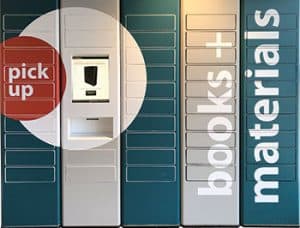
Making physical collections accessible remotely can go a long way toward providing access for people who can’t make it to the library. Whether it’s securely storing holds for 24-hour access or making portions of a collection available at offsite locations through a vending machine or an automated small branch, improving access outside traditional library hours can help underserved patrons take advantage of their library.
LendIT
D-Tech’s self-service library vending machine, LendIT, can be placed anywhere with a power outlet and internet connection with a fixed IP address. That could be right outside the library building or in a mall or community center. Users can browse available books on screen, with images and descriptions provided by the library’s discovery layer or generated by an onboard camera when books are loaded. Units with an optional clear front panel allow users to browse by looking directly into the machine, providing a more traditional experience.
D-Tech recently added a new software feature that gives users the ability to register for a library card at the machine. Information is forwarded to the library for approval. As soon as users are approved, they can check out items.
Patrons can choose to pick up holds at a LendIT location just like at a standard branch, if the library enables the feature and reserves space in the machine. Returned books are automatically checked back in and made immediately available for checkout, cutting down on circulation staff time. To add items to the machine, libraries can load up to 50 items at a time into the loading column to be placed by the onboard robot, or insert them one at a time via the item access door, similar to making a return. Kiosks are available in three capacities: 200, 500, or 1,000 items. LendIT will loan items of all types, up to 9.5 inches by 11.5 inches, provided they are RFID tagged.
Basic models start at $65,000, with additional features including custom colors and glass doors for an added cost. If located outdoors, LendIT also requires heating and cooling systems and a canopy for weather protection.
For more information, visit bit.ly/SolLendIT.
24-Hour Library
EnvisionWare’s 24-Hour Library is designed to act as a standalone, fully automated branch. Users can access Wi-Fi, search the library catalog, place holds, and check out physical and digital materials at any time of day.
Up to three users can browse items at the same time at the large 24-Hour Library, using two touchscreens mounted on the side and the front window and checkout screen. The three carousels inside the machine rotate independently and are usable concurrently.

The large unit holds up to 340 items, with 268 standard 12.5-by-8.25-by-1.6-inch slots; 67 wider 2.4-inch slots; and five hold drawers for larger items. It can accept almost three times its lending capacity in returns, with space for 1,000 items in 14 return bins. The smaller unit holds 235 items in 188 standard and 47 wide slots, with room for 600 returns. Both units allow for hold checkouts. Saving staff time, items on hold are automatically moved to the return bin for reprocessing if they are not picked up in the time allotted by the library.
The 24-Hour Library will broadcast a Wi-Fi signal in its proximity when it has a hardwired internet connection. Units without a wired connection can operate using 3G or 4G service to interface with the library’s systems but will not provide customer Wi-Fi access.
EnvisionWare provides project management, installation, and training for its 24-Hour Library. Typical budgets for installation, including the opening collection, start around $150,000, and EnvisionWare offers leasing options. For more information, visit bit.ly/Sol24hrLibrary.
Toledo Knows When to Hold ‘Em

User: Jason Kucsma, acting director/fiscal officer, Toledo–Lucas County (Ohio) Public Library
Product: remoteLocker
Description: Bibliotheca’s remoteLockers allow patrons to access their holds by providing a secure locker they can open using their library card.
How do you use remoteLockers?
The lockers are installed at several locations where we have a vestibule that can be left open during off hours. Customers can request hold materials to be placed in one of our lockers spread throughout the county.
How do remoteLockers serve your library’s needs?
The remoteLockers give us and our customers more flexibility for accessing library books and media at times that work with busy schedules. We assumed that the lockers would be used most heavily in the evening and early morning, but we’ve learned most people are using the lockers just a few hours before we open, during a lunch break, or a few hours after we close.

What are the main benefits?
One key benefit is the ability to provide a certain level of customer service to the community outside our regular hours. Aside from the added hours of access, the lockers could be used to expand access to library resources at locations other than library branches. We haven’t done this yet, but we know other systems have used these lockers at grocery stores and other places that don’t typically have a library presence. Additionally, we’ve heard from customers that the increased privacy of their holds is something they appreciate.
What would you like to see improved or added to the lockers?
In our experience, it would be helpful if there was an easier way to add additional items for the same customer to a locker, and it would be helpful if we were alerted to the fact that a specific customer already has items in a locker. We also ran into some challenges combining first-generation lockers with subsequent generations, so considering future interoperability will be important.


